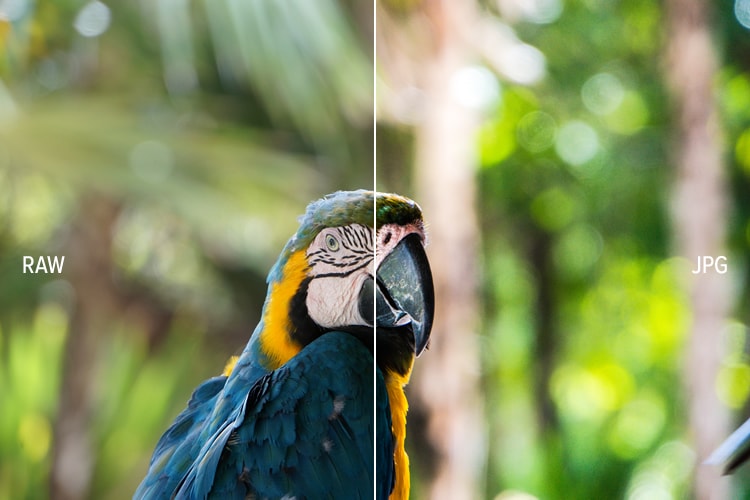RAW vs JPEG: the Technicalities Behind the Differences
One question that comes up often in photography circles is whether you should shoot in RAW or JPEG. For many of us, JPEG is a familiar mode and many cameras default to it as a format, but there are many advocates for RAW.
There’s many reasons why people would choose one format over the other as it depends on your situation and stylistic requirements. However, what a lot of people might not understand is what each format means, and how exactly they are different from each other.
If you have ever taken a photo in both formats and compared the two, you would have noticed differences in the images. Knowing how they are different is important to have a better understanding of what you’re using, and why.

This article is intended to talk about the technicalities behind both formats, rather than enunciate on the reasons why you should use one format over the other.
If reading technical articles makes you squirm and run due to their complicated nature – fear not, for this is intended as an easy-to-read guide.
What exactly is RAW, anyway?
Understanding what RAW means requires an understanding of how digital cameras work. You will notice a lot of articles talking about camera ‘sensors‘. A sensor is a silicon chip in the camera with millions of areas on its surface to detect light – which are called photosites. These photosites are designed to detect light, and have a small colour filter (either red, blue or green). In combination, all these photosites together form an image for your camera.
Think of a mosaic. Mosaics are formed by putting multiple coloured tiles together to form an image. A sensor follows that concept, except the tiles are so small they are barely visible to the human eye.
RAW format refers to the image formed when you’ve pressed the shutter button. It stores the raw data of the image to your camera – hence the term ‘RAW‘ (literally). The tech field usually love their acronyms, but this time RAW does not stand for anything esoteric. Depending on the camera, there might be some adjustment for noise, but usually any adjustment is minimal.
A good analogy for RAW format is to think back to film cameras. RAW is the equivalent of unprocessed film – the negatives. It is what the image appears as it was taken by the camera at that moment.
What about JPEG?
Unlike RAW, JPEGs contain an amount of processing. In each digital camera is a little processor that does a range of calculations, then applies it onto the stored image. Some of the processing it does includes white balance, saturation and contrast.
One thing you might have noticed about JPEGs is that they appear sharper than RAW. That is because when the camera converts to JPEG, it also runs a setting called Unsharp Masking (USM – here we go with the acronym love), which finds the edges between light and dark areas of an image and enhances the contrast. This gives the image some ‘pop‘ factor.
The JPEG format also compresses the data, making the image smaller. The intent behind the compression is to remove elements of the image that might not be perceptible to the human eye, thereby reducing its space requirements. Whether this is actually true or not depends on the level of compression, which most cameras will allow you to set – the higher the amount of compression, the more obvious it becomes. The main advantage of compression is that it allow you store more photos on a card, but at the disadvantage of losing some image quality.
The equivalent of a JPEG is processed film. The image has been adjusted in what the camera manufacturer believes is optimal, and then stored.
RAW and JPEG – a comparison
Below is a quick TL;DR comparison table between RAW and JPEG:
| RAW | JPEG |
|---|---|
| Not an image file, but a data file. Requires extensive post-processing for contrast, saturation and white balance. | An image file. May require some post-processing but the camera has already accounted for contrast, saturation and white balance. |
| Uncompressed, large file. | Compressed image, smaller size. |
| Not suitable for printing directly from the camera. | Can be printed straight from the camera. | Appears flatter due to minimal processing | Appears sharper due to Unsharp Masking (USM) |
Be honest – which is better?
Must we? Really? Okay fine, let’s quickly talk about the pros and cons of RAW and JPEG.
RAW gives you more control over the final appearance of the photo. You can tune an image to exactly what you want, because you have the unprocessed file. Most photo editing software now process RAW as well, so it has become easier to edit. You can then save them in formats such as TIFF or JPEG for printing and uploading.
RAW can also be rather time-consuming, so it depends if you are on a deadline. If you’ve ever experienced 24hr turn-around requirements, you’ll realize that RAW might not be the best idea. Especially if you have to process hundreds of photos at one time.
JPEG is quicker because some of the processing has already been done for you. You do have to relinquish some control over the image, and you lose some quality compared to RAW. On the other hand, if you’ve set up your camera parameters to just the way you want with compression at the lowest level, the amount of quality loss is barely perceptible when compared to a converted RAW image.
Really, there’s no hard or fast rule regarding whether you should shoot RAW or JPEG. It depends on your circumstances at the time. There’s no shame in shooting in JPEG, nor does RAW make you a member of the photography master-race – you pick and choose according to your needs.
